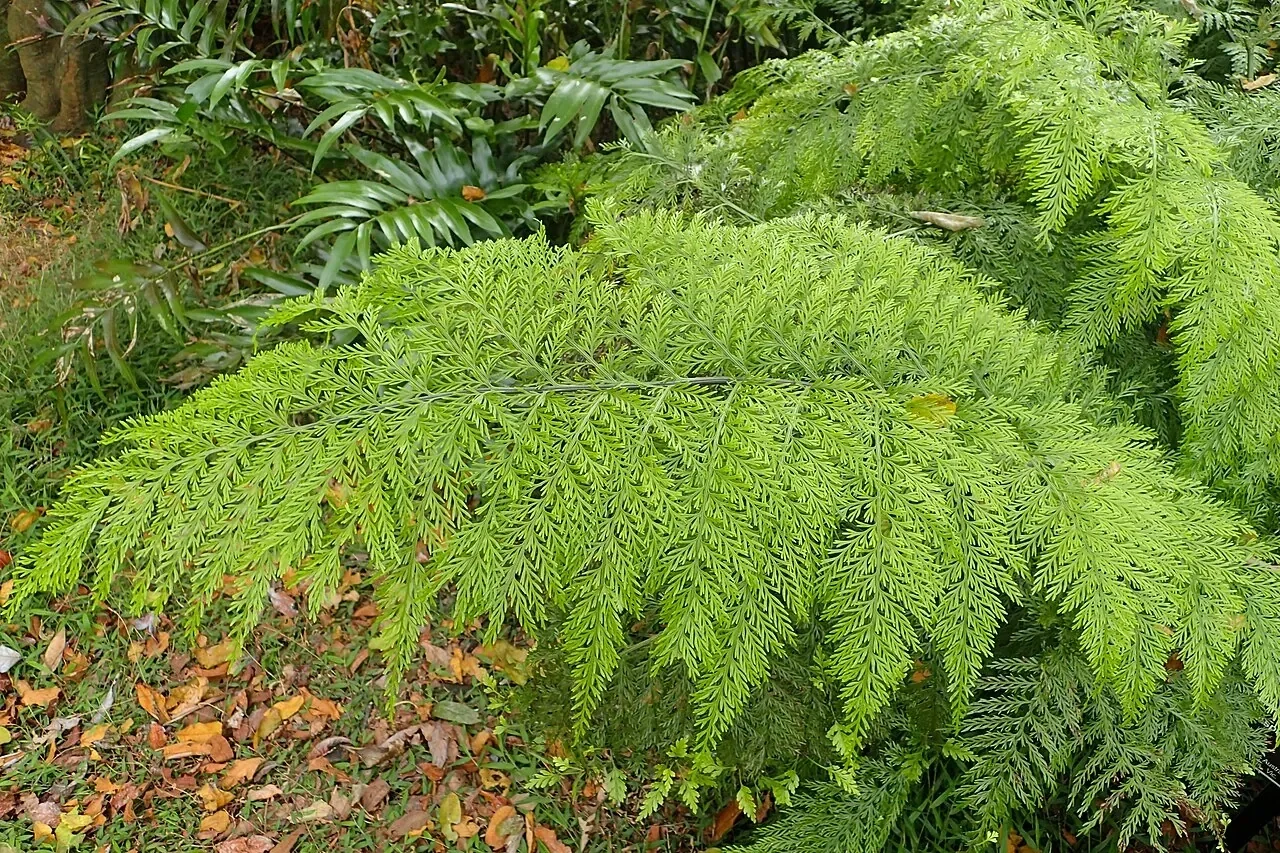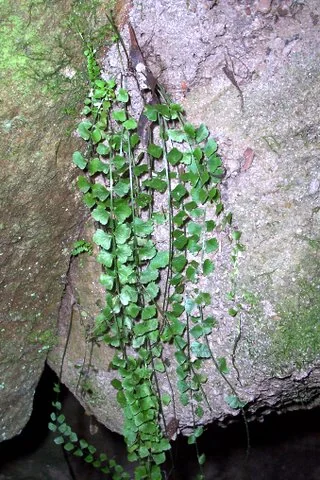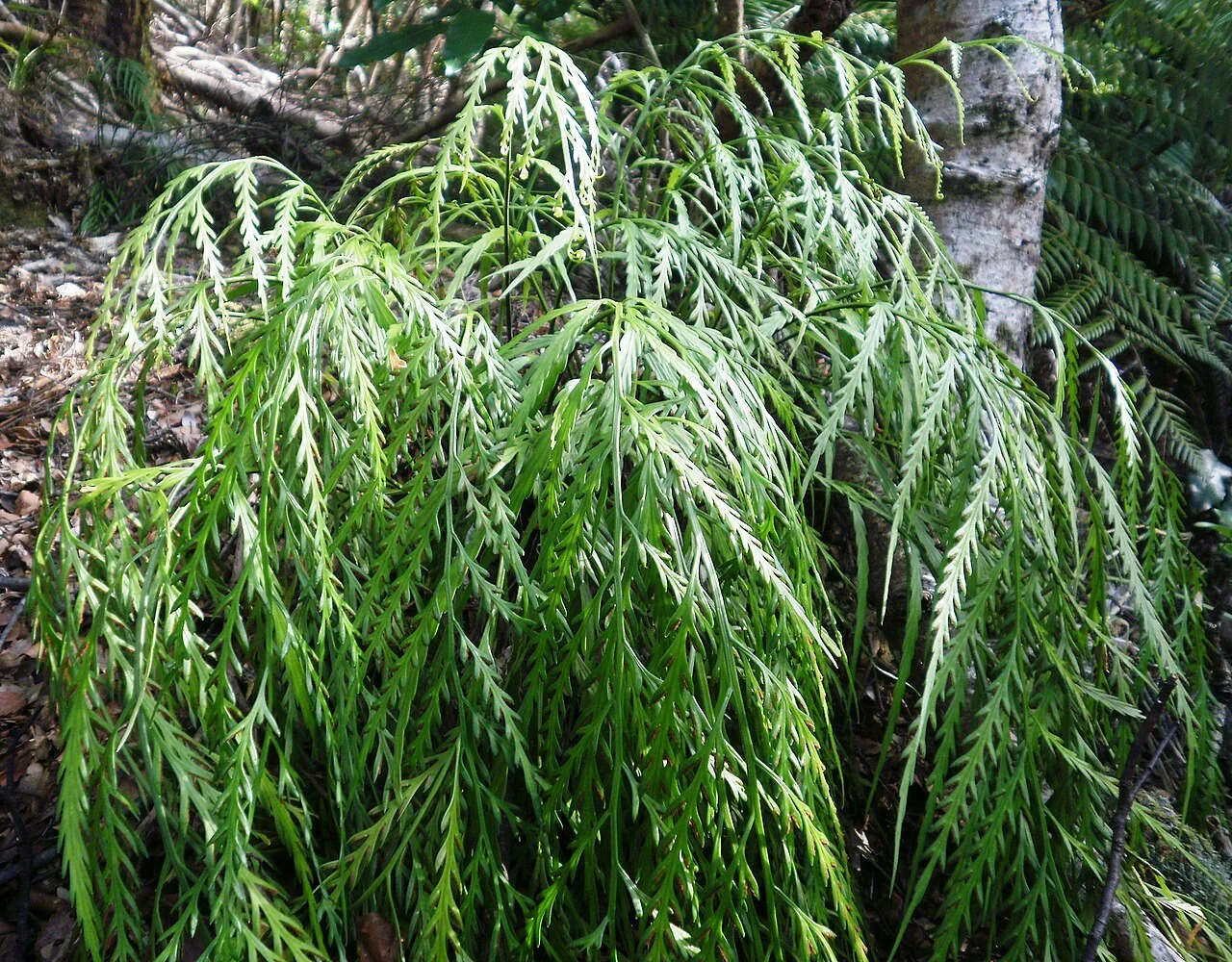
Maidenhair Spleenwort
Asplenium hookerianum
Maidenhair Spleenwort is a charming and highly variable indigenous New Zealand fern that forms elegant non-creeping tufts with delicate, lanceolate to rhombic fronds measuring 40-250mm long, featuring 5-15 pairs of narrowly ovate pinnae with distinctively stalked linear to suborbicular pinnules that create intricate, lacy displays ranging from 2-pinnate in smaller plants to 4-pinnate in larger specimens. This adaptable species demonstrates remarkable morphological diversity, with two or more seemingly different forms often growing together - some displaying broad, rounded segments while others show very fine, linear segments - yet all maintain the characteristic dull (rather than glossy) thin fronds and tufted growth habit that distinguish it from other aspleniums. Found from coastal to alpine elevations throughout most of New Zealand except scarce north of Waikato, this slow-growing fern thrives on shaded clay banks and rocky outcrops in scrub and open forest, making it an excellent choice for pot cultivation, shaded rock gardens, and naturalistic plantings where its delicate beauty and variable forms can be appreciated up close. native ferns .

Plant Description
Botanical Features
Maidenhair Spleenwort is a distinctive native plant with unique botanical characteristics that make it well-suited to New Zealand's diverse environments. This species exhibits typical features of its genus and family, with specialized adaptations that allow it to thrive in its natural habitat. The plant 's morphological features, including its leaf structure, growth habit, and reproductive characteristics, reflect millions of years of evolution in New Zealand's isolated environment. Understanding the botanical description of Maidenhair Spleenwort helps gardeners appreciate its unique characteristics and provides insight into its cultivation requirements and ecological role.
Quick Facts
Overview
| Scientific Name | Asplenium Hookerianum |
|---|---|
| Height | 0.04-0.25 meters (frond length) |
| Spread | 0.1-0.3 meters (compact tufted habit) |
| Water Needs | Moderate (shaded forest conditions) |
| Light | Shade (shaded banks and rocky outcrops) |
| Frost Tolerance | Excellent (coastal to alpine) |
| Salt Tolerance | Moderate (coastal native) |
| Growth Rate | Slow |
| Lifespan | Long-lived perennial |
Climate Best Suited to
Maidenhair Spleenwort is remarkably adaptable throughout New Zealand's diverse climates, thriving from coastal to alpine conditions. It demonstrates excellent tolerance to environmental variations and performs well across most climate zones.
Regional Suitability
| Whangārei | Ideal |
| Auckland | Ideal |
| Hamilton | Suitable |
| Rotorua | Suitable |
| Tauranga | Ideal |
| Gisborne | Ideal |
| New Plymouth | Ideal |
| Whanganui | Ideal |
| Palmerston North | Suitable |
| Napier | Ideal |
| Wellington | Ideal |
| Nelson | Ideal |
| Christchurch | Suitable |
| Dunedin | Suitable |
| Invercargill | Suitable |
| City | Climate Suitability |
|---|
Natural Habitat
Typical Environments
Occurs on shaded clay banks, rocky outcrops, and in open forest and scrub from coastal to alpine elevations across most of New Zealand (scarce north of Waikato). Prefers cool shade and well-drained, humusrich substrates.
Plant Conservation
Threats and Efforts
Maidenhair Spleenwort ( Asplenium hookerianum ) holds a national conservation status of "Not Threatened" in New Zealand, reflecting its widespread distribution across the North, South, and Stewart Islands, as well as the Chatham Islands. This status indicates that the species is not currently considered to be at risk of extinction at a national level.
Despite its secure national status, local conservation efforts are important to protect its diverse habitats, which include shaded clay banks, rocky outcrops, and open forests. While the species is adaptable and can be found in disturbed areas, it is still vulnerable to habitat degradation and competition from invasive species. The precise taxonomy of its different forms in New Zealand is still under investigation, highlighting the ongoing need for botanical research and monitoring. By preserving its natural environments and promoting its cultivation in appropriate settings, we can ensure the continued presence and genetic diversity of this delicate and historically significant fern.
Growing Requirements
Soil Requirements
Maidenhair Spleenwort has specific substrate preferences:
- Well-draining potting mix or forest soil
- Thrives on shaded clay banks in nature
- Adapts well to rocky substrates and outcrops
- Benefits from organic matter and leaf mold
- Excellent drainage essential for container growing
Light Requirements
Shade-loving preferences:
- Shade conditions preferred
- Naturally grows on shaded banks and rocky outcrops
- Excellent for deeply shaded garden areas
- Protection from direct sunlight essential
Water Requirements
Moderate moisture needs:
- Consistent moisture preferred
- Avoid waterlogged conditions
- Regular watering beneficial in containers
- Drought-tolerant once established
- Benefits from humid forest-like conditions
Planting Guide
When to Plant
The best time to plant Maidenhair Spleenwort is during spring when active growth begins and establishment is most successful.
Site Selection
Choose a site with:
- Shade conditions (essential)
- Protection from direct sunlight and strong winds
- Well-draining soil or potting mix
- Good air circulation
- Space for compact tufted growth
Planting Procedure
- Use well -draining potting mix or prepare forest soil
- Ensure excellent drainage in container or planting area
- Position plant to allow natural tufted habit
- Backfill with appropriate growing medium
- Water gently after planting
- Provide initial protection and humidity
- Allow space for variable frond forms to develop
Initial Care
Water regularly to maintain consistent moisture and provide shade protection. This slow -growing fern requires patience but rewards with beautiful, variable displays of delicate fronds.
Ecological Role
Ecosystem Roles
Valuable in shaded restoration planting for stabilising banks and increasing fern diversity. Its compact tufts fit into small niches, adding microhabitats for invertebrates and mosses.
Uses and Significance
Garden Uses
- Excellent pot plant for shaded patios and courtyards
- Rock gardens and crevice plantings
- Shaded ferneries and woodland gardens
- Indoor cultivation in bright, indirect light
- Naturalistic plantings on shaded banks
- Small-scale groundcover for challenging shaded sites
Cultural Significance
Traditional Uses and Values
While not as widely documented for traditional Māori uses as some other ferns, the delicate beauty of Maidenhair Spleenwort ( Asplenium hookerianum ) was appreciated. Its presence in the landscape was a sign of a healthy, moist forest environment.
Landscaping Uses
Practical Applications
Ideal for shaded rock gardens, troughs, and container displays where its fine detail can be appreciated. Stabilises small shaded banks and complements other miniature natives.
Seasonal Care Calendar
Spring
- New fronds emerge, keep soil moist
Summer
- Peak growing season with full frond development
- Maintain consistent moisture in containers
- Variable forms most apparent during active growth
- Provide protection from direct summer sun
Autumn
- Spore production and natural dispersal
- Continued attractive foliage display
- Good season for container cultivation
- Natural establishment of new colonies
Winter
- Evergreen fronds provide year-round structure
- Excellent frost tolerance (alpine adaptation)
- Slower growth during cooler months
- Reduce watering but maintain soil moisture
Pruning and Maintenance
Care Basics
Maidenhair Spleenwort requires minimal maintenance:
- Remove old or damaged fronds at any time
- Allow natural tufted growth habit to develop
- Generally best left unpruned to maintain delicate form
- Clean removal of dead fronds promotes healthy appearance
- Avoid disturbing the compact rhizome system
The delicate pinnate fronds and variable forms are the main attractions and should be preserved through minimal intervention to maintain the plant's natural beauty.
How to Grow Maidenhair Spleenwort
Spores
Spore propagation is the primary and most natural method for growing Maidenhair Spleenwort, utilizing the minute spores that are naturally wind-dispersed in forest environments where this delicate fern thrives. This indigenous New Zealand species produces fertile spores that can be successfully cultivated under controlled conditions, though the process requires patience and careful attention to environmental factors. The optimal timing for spore collection is during late summer to autumn when the sori (spore clusters) on the undersides of mature fronds have ripened from green to brown, indicating full spore maturity. Monitor established plants carefully, as spore production can vary significantly between individuals and growing conditions. To collect spores, select healthy, mature fronds with clearly visible brown sori and cut them carefully with clean scissors. Place the cut fronds in clean paper envelopes or bags and store in a warm, dry location for 3-5 days to allow natural spore release. The released spores appear as fine, dust-like particles that should be sown immediately at 15°C for optimal germination rates. Prepare a sterile growing medium using equal parts finely chopped sphagnum moss, peat moss, and perlite, sterilizing the mixture with boiling water and allowing it to cool completely. Sow spores thinly on the moist surface and cover containers with glass or clear plastic to maintain the high humidity levels essential for successful germination. Maintain consistent temperatures around 15°C with bright, indirect light, ensuring the growing medium remains consistently moist but not waterlogged. Germination is typically slow and irregular, taking several weeks to months for the initial prothallus stage to develop, followed by many additional months for recognizable fern sporophytes to emerge. Young plants require careful protection from environmental fluctuations and may benefit from being covered with plastic until well established, as this species can be rather slow-growing compared to other native ferns.
Division
Division offers a more reliable alternative to spore propagation for Maidenhair Spleenwort, particularly valuable when working with established cultivated specimens that have developed sufficient crown divisions for separation. This tufted fern naturally forms compact clumps through slow rhizome growth, creating multiple growing points that can be carefully separated to form independent plants. The optimal timing for division is during spring when new growth is beginning to emerge, providing the best opportunity for rapid establishment of divided sections. Begin by carefully lifting the entire clump using a small hand fork or trowel, working slowly around the perimeter to avoid damaging the delicate root system and emerging fronds. Maidenhair Spleenwort typically has a more compact and less extensive root system than larger fern species, requiring extra care during handling. Once lifted, gently shake away excess soil to expose the rhizome structure and identify natural divisions where separate crowns have developed. Use clean, sharp knife or small pruning shears to cut through connecting rhizomes, ensuring each division includes both healthy roots and at least one active growing point with visible fronds or emerging shoots. Due to the naturally slow growth rate of this species, divisions may be smaller than those of faster-growing ferns, but they establish well under suitable conditions. Replant divisions immediately in humus-rich, moist but well-draining soil with added grit for improved drainage, positioning them at the same depth they were previously growing. Choose locations with partial shade and protection from direct sunlight, as this species naturally occurs in shaded forest environments. Water thoroughly after planting and maintain consistent soil moisture throughout the establishment period, typically 8-12 weeks during favorable conditions. This method is particularly useful for maintaining specific genetic characteristics and for gardeners who want to avoid the technical challenges and extended timeframes associated with spore propagation.
Container Cultivation
Container cultivation represents the most practical and successful approach for most gardeners wanting to grow Maidenhair Spleenwort, taking advantage of the species' reputation as an excellent pot plant while providing the controlled growing conditions necessary for optimal development. This approach effectively bypasses the challenges and extended timeframes associated with spore propagation while allowing precise management of environmental factors critical to this species' success. Asplenium hookerianum thrives in container culture due to its naturally compact growth habit and preference for well-drained conditions that containers readily provide. Choose containers with excellent drainage, such as terracotta pots or specialized fern containers, as waterlogged conditions can quickly damage the sensitive root system. Use a specialized growing medium that replicates forest floor conditions, combining humus-rich compost, leaf mold, coarse sand or grit, and perlite in proportions that provide both moisture retention and rapid drainage. Position containers in locations that receive partial shade throughout the day, avoiding direct sunlight that can stress the delicate fronds. The naturally slow growth rate of this species means that container-grown specimens require minimal repotting, typically only every 3-4 years when they become root-bound. Maintain consistent moisture levels without allowing the growing medium to become waterlogged, and provide additional humidity through misting or humidity trays, especially in drier environments. Be vigilant for common pests such as scale insects and mealy bugs, which can affect all Asplenium species in cultivation, and treat promptly with appropriate organic or targeted treatments. Regular feeding with diluted liquid fertilizer during the growing season supports healthy development, though this species' modest nutritional requirements mean feeding should be light and infrequent. Container cultivation also allows gardeners to move plants to optimal microclimates as seasonal conditions change, ensuring the consistently favorable conditions this sometimes challenging native fern requires for long-term success.
Container Growing
- Provide bright , indirect light
- Wait for gametophyte and then sporophyte development
- Transplant young ferns when large enough to handle
From Division
Division is possible but requires care:
- Carefully divide established tufts in spring
- Ensure each division has rhizome and root system
- Replant immediately in suitable shaded conditions
- Provide high humidity and consistent moisture
- Recovery may be slow due to slow growth rate
Natural Colonization
Wind-dispersed spores naturally establish new colonies on suitable shaded banks and rocky outcrops, particularly in disturbed forest areas.
Pests and Diseases
Generally Hardy
- Forest Adaptation: Well-adapted to natural shaded conditions
- Alpine Tolerance: Hardy constitution from coastal to alpine zones
- Environmental Resilience: Thrives in challenging rocky substrates
Common Issues in Cultivation
- Scale Insects: Prone to scale infestations in container cultivation
- Mealybugs: Common problem for all aspleniums in cultivation
- Root Rot: Can occur in waterlogged or poorly-draining substrates
Management Strategies
- Regular Monitoring: Check regularly for scale and mealybug infestations
- Good Drainage: Ensure excellent drainage to prevent root rot
- Air Circulation: Provide good air movement without drying winds
Prevention
Provide appropriate shaded conditions with good drainage and air circulation. Regular inspection for pests is essential in container cultivation, as this slow-growing fern benefits from early intervention when problems arise.
Bonus Tip
Appreciating Morphological Variability
Maidenhair Spleenwort ( Asplenium hookerianum ) is renowned for its remarkable morphological variability. You might find plants with broad, rounded segments growing right alongside others with very fine, linear segments, even in the same microhabitat.
The bonus tip is to embrace and appreciate this natural diversity! When cultivating this fern, don't be surprised if different specimens exhibit distinct frond forms. This variability is a key characteristic of the species and adds to its charm, making each plant a unique botanical treasure. Observing these differences can be a rewarding aspect of growing Asplenium hookerianum .







